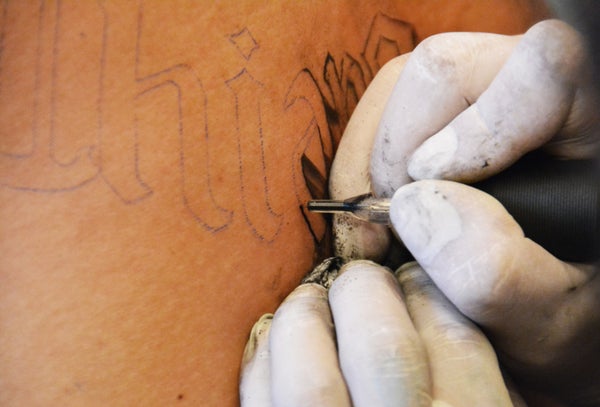People who are thinking about getting inked are often told, “a tattoo is for life.” Etched into the layer of skin just below the epidermis, they are notoriously difficult to remove. And the laser surgery method for doing so is costly, time-consuming and—often—has far from perfect results.
A new discovery published Tuesday in The Journal of Experimental Medicine may eventually change the situation: It fleshes out the cellular processes that make tattoo ink so persistent, and offers a new strategy for potentially removing it more effectively. A French research team found that blocking the immune system’s own macrophages—cells that identify and engulf cellular debris, microbes and other foreign bodies—would likely help erase tattoos’ permanence.
Immunologist Sandrine Henri of The French National Institute of Health and Medical Research, the National Center for Scientific Research, and Aix Marseille University, and her colleagues research the origins and genetics of skin macrophages in order to understand how they interact with other immune cells in the skin. Tattoos have not been a focus of their work, but their new study suggests they may have stumbled on a discovery that could change the future of ink removal: They found mice with black coats appear to have a specific type of skin macrophage that ingests pigment particles when the cells that normally store the particles die off. Follow-up experiments, described in the new paper, suggest macrophages may also play a role in absorbing particles of tattoo ink.
On supporting science journalism
If you're enjoying this article, consider supporting our award-winning journalism by subscribing. By purchasing a subscription you are helping to ensure the future of impactful stories about the discoveries and ideas shaping our world today.
First the team worked to prove macrophages take up tattoo pigment. They genetically engineered a strain of mice to have skin macrophages with diphtheria toxin receptors; this gave the researchers the ability to selectively kill off those cells by injecting the mice with the toxin. Next they tattooed the animals’ tails with green fluorescent ink and examined sections of the tattooed skin under a microscope to confirm the ink particles are indeed taken up by the macrophages. Then the researchers exposed the animals to the diphtheria to kill off these cellular trash collectors.
Although the macrophages died as expected, the researchers were surprised to see the ink persisted for many months—even after all the macrophages that had taken up the ink particles had been replaced. In another set of experiments the tattooed tail skin was grafted onto the backs of albino mice. Again, the researchers found that six weeks later, although the cells in the graft had all died, the ink remained.
So how is that possible? The work suggests tattoos endure because their pigment is consumed by one macrophage after another: When one dies, it simply releases the ink particles it had been storing. Then another macrophage comes along, clears away the cellular debris and engulfs the particles.
“The fact that macrophages hardly move within the skin explains why the tattoo is pretty stable,” Henri says. “Moreover, the pigment particles present in tattoo ink are quite big—and owing to their size they aren’t drained into the lymph nodes via the lymphatic vessels. So as soon as they are released by dying macrophages, they remain stuck until another macrophage ingests them.”
Simon Yona, an immunologist at University College London who studies macrophages and was not involved in the new work, praised the way the researchers engineered their experimental animals. “We were really in the dark about how tattoo pigments stay within the skin for such long periods of time,” he says. “But this beautiful study identifies the cells that take up tattoo ink. It’s an exciting advance that has the potential to be developed further,” he adds. “It really does provide a strategy to remove unwanted tattoos, in combination with conventional approaches, which could be especially useful for removing small tattoos in a well-defined location.”
Henri says she and her colleagues are already on their way to developing a method for delivering genetic instructions to specified types of immune cells, and they plan to work closely with dermatologists on the next stages of their work. She hopes laser tattoo removal could work better if performed in combination with the temporary inhibition of skin macrophage function. With this approach, she says, “the pigment particle fragments generated by the laser pulses would not be immediately recaptured by macrophages—increasing the likelihood that they will drain away via the lymphatic vessels.”
As with most therapies, however, there may be risks. Although feasible in principle, this alternative approach would need rigorous safety testing—because blocking macrophage function has been shown to inhibit wound healing, and also can impair the regeneration of skeletal muscle.
